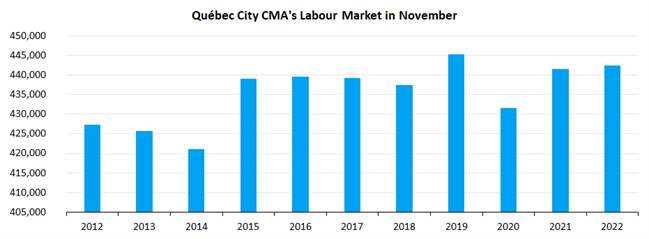Highlights
- In the Québec City census metropolitan area (CMA), Statistics Canada estimated that there were 442,500 jobs in November 2022, a similar level to that of last year (+0.2%). Over the past three months, the labour market has slowed down, with a drop of 2,800 jobs (-0.6%).
- The Québec City region registered a second monthly increase in the unemployment rate (+0.1 percentage points – pp). Nevertheless, there is still full employment in the region, which maintains the lowest unemployment rate (3%) among major Canadian CMAs.
- Moreover, we can see an increase in employment over one year in several sectors, especially health and manufacturing. On the other hand, employment has declined in educational services as well as wholesale and retail trade.
- The participation rate reached 65.6% in the Québec City CMA, a level similar to November 2021 (65.8%).
- Comparable data show that the labour market remained relatively stable over one year in the province of Quebec (+1.9%) and Canada (+2.3%), with unemployment rates of 4.1% and 5.1%, respectively.
Charts
 Source: Statistics Canada. Table 14-10-0380-01.
Source: Statistics Canada. Table 14-10-0380-01.

Cautionary Note
The available data for the Québec City CMA was given special statistical treatment (three-month moving average) due to the small sample size, which has the effect of mitigating the large fluctuations in the data. Thus, data collected in September and October influenced the estimations published for November. Please also note that we use comparable data for the province of Quebec and the other CMAs in this document.
Commentary
In November 2022, the Québec City region’s labour market showed stability in employment, with a 0.1% decrease compared from October. Annual results are the same: there were 442,500 jobs in November 2022, a level similar to that of November 2021 (-0.2%).
Despite this small overall fluctuation, non-seasonally adjusted data show significant variation from sector to sector. From November 2021 to November 2022, employment grew in several sectors, especially health and manufacturing, while decreasing in educational services as well as wholesale and retail trade.
The unemployment rate went from 2.9% in October 2022 to 3.0% in November 2022 (+0.1 pp), a second monthly increase in a row. However, the market remains in full employment, with the second-lowest rate in Canada, and by far the lowest rate among the regions of more than 500,000 residents.
Market participation, which is measured by the participation rate, also remained stable compared to the previous year. In November 2022, the participation rate was 65.6%, a similar level to that registered in November 2021 (65.8%). Note that labour market participation is higher in the Québec City region than in the province of Quebec and Canada.
In conclusion, the labour market shows signs of a slowdown as we near the end of the year but remains very tight and relatively stable over a 12-month period. On December 19, new data from Statistics Canada about the number of vacant positions will enhance our understanding of the market and its labour needs. We will publish a note on the subject.
Émile Émond
Economist
Québec International




